GOD’S BEST BERRY?
First Good-Tasting Berries of the Season
Strawberries, the aptly named variety Earliglow, are ripe, which means it’s time to start crawling for fruit. That’s one thing I don’t like about strawberries.
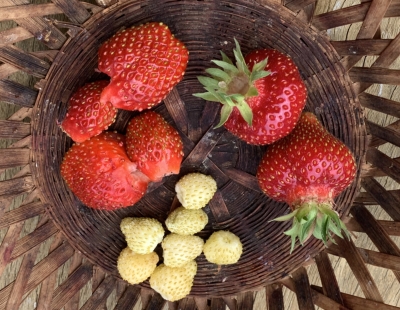
Strawberries, garden, vescana, and alpine
Another thing I don’t like about strawberries is that, although they’re perennial plants, a bed needs replanting after about 5 years. By then, viruses, fungal diseases, weeds, and just plain aging have finally taken their toll. The decline creeps up slowly so is not all that obvious. And no, you shouldn’t replant in the same spot where the now pest-ridden bed was, but in a new location. And don’t replant with rooted runners from those old plants, but with new, certified disease free plants.
Any bad feelings I had dissolved away as I tasted my first berry of the season. I almost agreed with Izaak Walton, in the 16th century, “Doubtless God could have made a better berry, but doubtless God never did.” (He had never tasted our native highbush blueberries.) Aside from good flavor, strawberries bear quickly, their first or second season in the ground, and are the first good-tasting, fresh berries of the season.
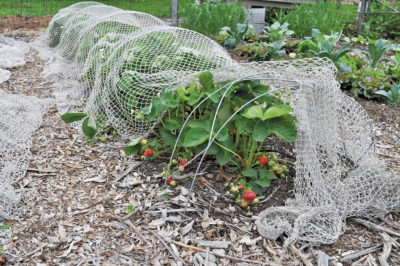
I planned ahead, this being my planting’s fifth year, ordering plants for spring planting and setting them in a relatively weed free bed in my vegetable garden, two rows running up and down a three-foot-wide bed with a foot between plants in the rows. Right after harvest, out goes the old bed, to be given an inch dressing of compost and then in go leek and/or fall cabbage and cauliflower plants.
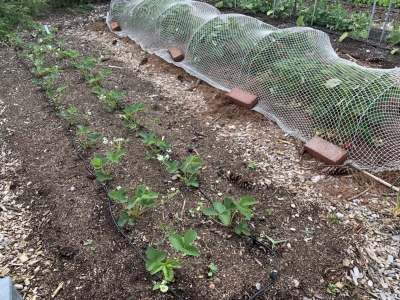
Strawberries, new and old bed
I’ll keep the new bed productive for its five years with annual renovation, a brutal affair that begins with, right after berries have been harvested, lopping off and raking up all the leaves, etc., etc. No need to dwell on this now, while enjoying berries from the old bed.
A Strawberry Better than a Strawberry
Conventional garden strawberries (Fragaria X ananassa) aren’t the only strawberries on the block. I’ve written previously about another kind of strawberry, alpine strawberry (Fragaria vesca), which is a totally different species than garden strawberries. Sure, they also have their downsides: they’re small, typically dime size; they’re very soft and perishable; and after two or three years, plants get old at their center so either need to be divided, or chucked, and new plants started.

Pineapple Crush alpine strawberries
On the plus side, new plants are fairly easy to start from seed, similar to growing tomato transplants except needing more patience. And the plants bear their first season. Not only bear their first season, but bear more or less continuously all season long.
Alpine strawberries are very resistant to pest problems. And birds? No problem if you grow Pineapple Crush, the white ones. The birds ignore them. Pineapple Crush berries also have the best flavor, with more than a hint of pineapple.
I’ve been testing people’s reactions to tasting my white alpine strawberries. Without fail, within seconds of putting one in their mouth, a person’s eyes light up and they exclaim “Wow.”
Trying for the Best of Both Worlds
Okay, alpine strawberries are small. You’re not going to fill your freezer with these strawberries. Hmm, how about combining the best of garden strawberries and the best of alpine strawberries? It’s been done. The hybrids are called vescanas, botanically Fragaria X vescana, a combining of their parents’ botanical names.
As a fan of alpine strawberries, how could I resist searching for these hybrids? I found some and, last spring, planted them, the varieties Annelie, Rebecka, Sara, Florika, and, not sounding very appetizing in name, S-228. The alpine genes express themselves in disease resistance and bearing fruit more or less continuously through summer and into fall. Garden strawberry struts its genes in the hybrids’ fruit size which, for the hybrids is much larger than the alpine strawberries but smaller than the garden strawberries.
The fruits are red but red alpine strawberries, which are more common than white alpine strawberries, might have been used in the breeding.
Most evident in coming upon my small patch of these vescanas is how fast they are spreading. There are runners all over the place! I usually frown on such a habit because keeping my strawberry bed from becoming overcrowded necessitates pinching off all runners except for those needed to put rooted plants in place to replace old plants.
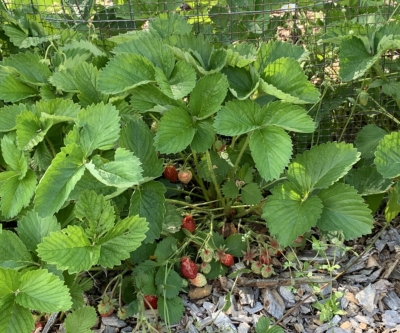
Vescana strawberries
Making lots of runners is billed as an asset for the vescanas, allowing them to be grown as so-called meadow strawberries, the meadow needing neither renovation nor mulching. I’ll let my plants wander off somewhere by themselves and see how they fare.
You may have noticed that there’s an elephant in the room; up till now there’s been no mention of flavor. I was saving that. Quoting from a journal article by the breeders of Rebecka, this variety has “fine aroma.” Perhaps in Sweden where that variety was bred. Or, quoting from the patent for Florika, “The variety is a vescana-type strawberry plant characterized by its capability of developing exceptionally rich and fine flavor of medium sized fruits.” Perhaps in Germany, where this variety was bred.
Here in New York’s Hudson Valley, I thought the fruits were good, but nothing special, and surely not as especially good as my Pineapple Crush white alpine strawberries.
Now that I think of it, Izaak Walton’s very high praise of strawberries might have been more warranted than I first noted. So-called garden strawberries are relative newcomers on the garden scene, originating as a chance hybrid in the 18th century. Prior to its arrival, the strawberries that were grown or harvested from the wild were mostly the musk strawberries (Fragaria moschata, very delicious) and alpine strawberries.
I haven’t said “wow” upon tasting any of my vescana strawberries.
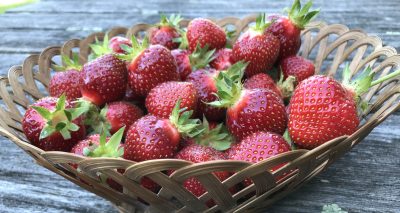
Earliglow strawberries
(For more about growing strawberries, see my book Grow Fruit Naturally).


what seed company sells the Pineapple Crush variety of the Alpine strawberry?
I don’t know. I bought the seed ages ago and now save my own seed.
I bought an pineapple crush from you 3 years ago. When my friends taste it for the first time their eyes light up and say “ wow” haha it’s my favorite variety!!!
For a joke, we should tell friends “I bet I can make you say “Wow.” Wait 15 minutes or more so the bet is forgotten, then give a taste of Pineapple Crush.
I have beautiful strawberry plants every year, filled with berries. Alas, I have yet to taste one, as the ‘munks eat every one. I cover them, and they still get in.
Cats?
Dear Lee,
I enjoy your blog, especially because here in Beacon we have the same Hudson Valley climate. Also love your Growing Fruits Naturally book.
But I must say this: I have a patch of Earliglow strawberries that we planted in 1995 that is still going strong. My husband does a little thinning of the old plants when he picks the last berries of the season. Other than that, all I do with them is an organic strawberry fertilizer about once a year, cover with raked leaves in the fall and a thick mulch of peat moss in the spring. We get big delicious berries and I make batches of jam and plenty of strawberry daiquiris every June.
Mary Kate
I don’t doubt that your Earliglow patch is doing well. Annual renovation and replanting after 5 years is just a way of increasing the chances of success. My 5-year-old bed seems fine but I’m still going to take it out after the harvest. Also, be aware that, although yield might be sufficient, the bed could be experiencing a slow dropoff in yield or quality over time. Or maybe not.
How far from the old strawberries should the new row be? It looks in the photo like right “next door” is ok? Come to think of it, is this the same distance you recommend for other fruit/vegetable rotation, too, or does it vary by plant type?
My distance probably isn’t ideal but it fits well into my garden scheme. And seems to work well.
What a great post! Learned so many great tips that I can’t wait to try in my garden. Thanks a million!
I’m sold on Pineapple Crush! Just ordered some seed and I see germination can be challenging but I’m willing to try. Any suggestions for success in germination as well as collecting and saving seed for the future?
One word: patience.
An answer to someone else’s question … and a question of my own 🙂
Seeds for Pineapple Crush (and a number of other alpine strawberry varieties) can be purchased from “The Strawberry Store”; just note that their stock goes quickly.
http://thestrawberrystore.com/
And I was wondering where you purchased the vescana strawberries from. I haven’t been able to find any US vendors.
I got the vescanas for research purposes from the USDA germplasm site in Corvallis.
Hi Lee,
thanks to your post I realized what I have been growing for years as ‘Florika’ isn’t really Florika, the berries are even smaller than my Alpine strawberries and they only fruit once in June, when I have more than enough strawberries! I tried to remove them the easy way by covering them with 8 inches of woodchips, but they came back just as strong!
If you have the ability to get it, you should try the variety ‘Mieze Schindler’, it is an old german variety (I live in Germany) which is absolutely delicious, it also elicits ‘wows’ from everyone that tries it. To me it is even better flavor than the alpine. It needs to go from plant to mouth or plant to freezer, the fruits are very soft and barely keep a few hours.
Kind Regards,
Selena